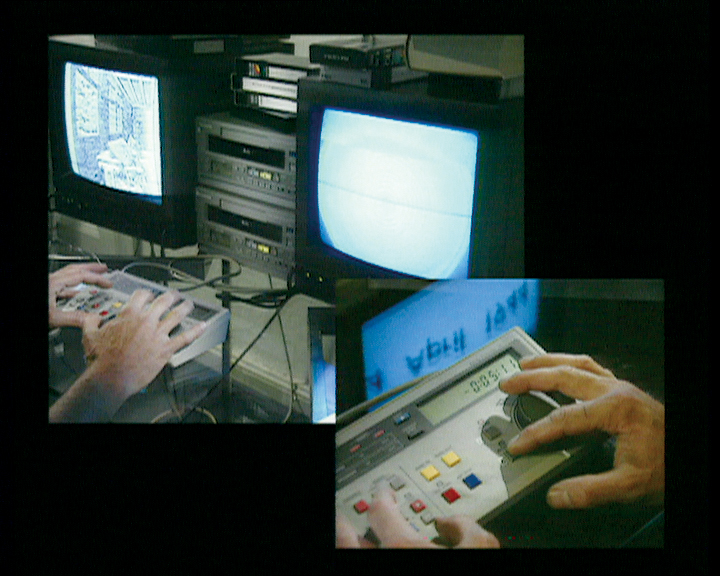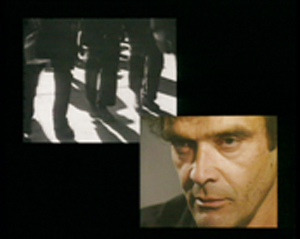[Spring 2008]
Leonard and Bina Ellen Art Gallery, Montreal
October 19 – December 1, 2007
Harun Farocki: One Image Doesn’t Take the Place of the Previous One, at Concordia University’s Leonard and Bina Ellen Art Gallery last fall, brought the German artist to Montreal for the first time. Although he has made over ninety film and video works, Farocki is not well known here, or in North America, for that matter. The linchpin in a cluster of linked activities surveying Farocki’s forty-year career, including an international conference and a film retrospective, this exhibition, curated by gallery director Michèle Thériault, may do much to change that.1
One Image Doesn’t Take the Place of the Previous One takes its title from a statement that the artist made about the use of multiple channels in his installation work. “It’s a matter of ‘soft montage,’” Farocki explained, referring to the simultaneity of multiple projections. “One image doesn’t take the place of the previous one, but supplements it, reevaluates it, balances it.”2 This statement also describes the organizational logic of the artist’s linear, time-based film work. The dual and multiple screen presentations develop logically the dialectical principles and constellation-like schema shaping what, for the most part, has been a “found footage” film practice. Single-mindedly concerned with the social and political functioning of “the image,” Farocki typically groups visual material from diverse sources and of different, more and less obviously related phenomena to analyze the practical effects and ideological operations of the contemporary image world. Envisioned in the artist’s work through what he terms “operational” imagery, this world of pictures tends to shape the sphere of everyday life obliquely, but with clearly defined instrumental purposes and certain alienating effects: surveillance cameras, industrial robotics, computer simulations, and sensing systems, pictures more and less directly connected to the world of things: operational pictures without operators.
Although not a retrospective in the traditional sense, Thériault’s selection of works offers a historical and thematic range that sketches a comprehensive account of the artist’s oeuvre. In addition to the four recent installation works that are make up the bulk of the exhibition, the show includes Inextinguishable Fire (1969), an example of Farocki’s early “agitprop” film work, and Section (Schnittstelle) (1995), a transitional two-channel video “self-portrait” that features the artist discussing the different representational and organizational considerations in his film and video practices.
Farocki never approaches his subject directly but arrives more circuitously, laying out his critical themes in clusters around a central, often absent, point of concern. The third in a series of works addressing operational imagery, the dual-projection installation Eye/Machine III (2003) weaves found imagery taken from flight simulators, military guidance systems, and various robotic sensing devices together with instructional films and commercials to factor the extreme alienation effected by the representational operations of post-industrial technologies. Though the imaging systems are the overt subject, the evacuation of humanity, of subjectivity itself, from representational practice is the absent but defining term of the work.
Counter-Music (2004) groups corresponding imagery around a similar theme. Pictures from surveillance cameras trained on laboratory subjects, city streets, and subway platforms, archival footage of mid-twentieth-century factory workers at their machines, and more recent documentary footage of surveillance control rooms with technicians at their posts are laced with clips from Dziga Vertov’s and Walter Ruttmann’s City Symphony films and elements of text. “For Vertov the day begins with the production of images. For us it is their reproduction.” Evacuation from any direct relation to production is suffered equally by the worker and the artist, here conceived as a cultural worker.
Thériault’s exhibition unfolds in like fashion. Referencing the absent term that links each of the other installations, Workers Leaving the Factory in Eleven Decades (2005) lies at the physical and conceptual heart of the exhibition. Composed of a row of twelve monitors, each playing a film clip from one of the eleven decades of cinema, the series begins with the Lumiere brothers’ film referred to in the work’s title and concludes with a clip from Lars von Trier’s Dancer in the Dark (2000); each decade in between offers a supplementation and re-evaluation of this modern trope of collectivity. Linking the world of cinema to that of the operational image, the work mixes documentary with fiction film; the selection includes such diverse material as Charlie Chaplin’s Modern Times (1936) and Michealangelo Antonioni’s Red Desert (1964), an anonymous documentary film from the Moscow National Film Archive (1912), and a clip from Jean-Marie Straub and Daniele Huillet’s proto-documentary film Too Early, Too Late (1981).
That such imagery has operational effects is illustrated brilliantly in Dubbing (2006), the work that meets the spectator at the gallery door. Shorter and simpler than most of Farocki’s work, Dubbing loops the infamous clip from Martin Scorsese’s Taxi Driver (1980) in which Travis Bickle is so caught up in the fiction of the image that he can’t recognize himself anymore. Each loop dubs the legendary lines in another language: “Who you looking at? There’s no one here but me” – and this loop of dubs is looped and looped again, to spin on endlessly. Simultaneously familiar and strange, much like the identificatory process within which Bickle is caught, recognition and misrecognition represent two sides of the same coin of subject formation.
Farocki’s concern with the alienation effect of representation tout court should not be dismissed as mere nostalgia for the loss of human agency. Instead, it should serve as a caution to take all representation seriously; not merely as the means to any specific representational end, but more as a cultural artefact, the primary tool and product of a political economy geared toward the removal of human consciousness for the sake of efficiency.
Cheryl Simon is an artist, academic, and curator whose current art and research interests include explorations of time in media arts and collecting and archival practices in contemporary art. She teaches studio arts at Concordia University and cinema + communications at Dawson College.



